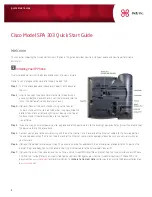
2.3.1 Keypad/LCD and Receptacle Part
Once the keypad is pressed, the key signals are sent out to MSM6050 for processing. In addition, when the
key is pressed, the keypad/LCD lights up through the use of 16 LEDs. The terminal status and operation are
displayed on the screen for the user with the characters and icons on the LCD.
Moreover, it exchanges audio signals and data with external sources through the receptacle, and then receives
power from the battery or external batteries.
2.3.2 Audio Processing Part
MIC signals are amplified through OP AMP, inputted into the audio codec(included in MSM6050) and
converted into digital signals. Oppositely, digital audio signals are converted into analog signals after going
through the audio codec. These signals are amplified at the audio amplifier and transmitted to the ear-piece. The
signals from MSM6050 activate the ringer by using signals generated in the timer in MSM6050.
2.3.3 MSM Part
MSM6050 is the core element of CDMA system terminal that includes ARM9TDMI microprocessor core. It
supports both CDMA and Digital FM, operating in both the cellular and PCS spectrums. The subsystems within
the MSM6050 include a CDMA processor, a DFM processor, a multi-standard Vocoder, an integrated wideband
mono voice CODEC, general-purpose ADC for subsystem monitoring, an ARM9TDMI microprocessor, and
both Universal Serial Bus(USB) and an RS-232 serial interfaces supporting forward and reverse link data
communications of 153.6 Kbps simultaneously. And it also contains complete digital modulation and
demodulation systems for CDMA standards, as specified in IS-95-A/B. In MSM, coded symbols are
interleaved in order to cope with multi-path fading. Each data channel is scrambled by the long code PN
sequence of the user in order to ensure the confidentiality of calls. Moreover, binary quadrature codes are used
based on walsh functions in order to discern each channel. Data created thus are 4-phase modulated by one pair
of Pilot PN code and they are used to create I and Q data. When received, I and Q data are demodulated into
symbols by the demodulator, and then de-interleaved in reverse to the case of transmission. Then, the errors of
data received from viterbi decoder are detected and corrected. They are voice-decoded at the vocoder in order to
output digital voice data.
26
Z3X-BOX.COM
Содержание LG- PX240
Страница 16: ...16 Z 3 X B O X C O M ...
Страница 18: ...18 Z 3 X B O X C O M ...
Страница 21: ...21 Z 3 X B O X C O M ...
Страница 22: ...22 Z 3 X B O X C O M ...
Страница 43: ...Figure 4 3 1 PMIC MAX1827ETL T FUNCTIONAL BLOCK DIAGRAM 4 3 Logic Part Trouble 43 Z 3 X B O X C O M ...
Страница 66: ...Circuit Diagram Figure 4 3 32 LCD 40PIN CONNECTOR Figure 4 3 33 MAIN 60PIN CONNECTOR 66 Z 3 X B O X C O M ...
Страница 86: ...Z 3 X B O X C O M TX RX PX240 ...
Страница 87: ...Z 3 X B O X C O M TX RX Audio MIC Audio Earphone Audio Receiver Speaker PX240 ...
Страница 88: ...Z 3 X B O X C O M PX240 ...
Страница 89: ...Z 3 X B O X C O M Audio MIC Audio Earphone Audio Receiver Speaker PX240 ...
Страница 90: ...Z 3 X B O X C O M PX240 ...
Страница 91: ...Z 3 X B O X C O M PX240 ...
Страница 92: ...Z 3 X B O X C O M PX240 ...
Страница 93: ...Z 3 X B O X C O M ...
















































